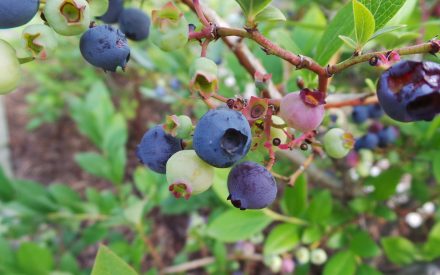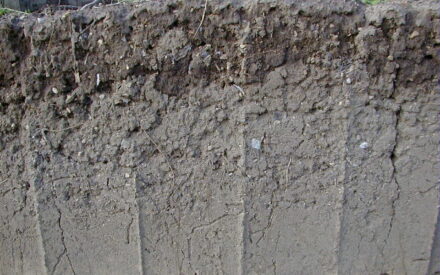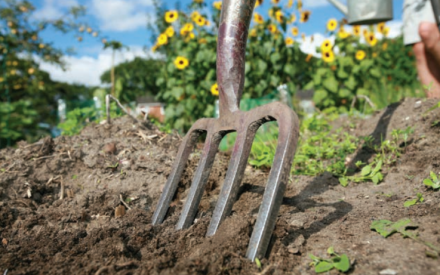
Sherry Combs, formerly of the UW-Madison Soil and Plant Analysis Lab
Revised: 10/27/2007
Item number: XHT1151
Is your soil pH too high? Probably not, although the popular press urges most gardeners to question whether their garden soil pH is ‘right’. Only a soil test for pH can indicate whether the pH is ‘right’, and ‘right ‘ really depends on the plant you want to grow and the natural pH of your soil. Turf, vegetables, annual ornamentals and most perennial ornamentals are very tolerant of a wide range of soil pH levels, and acidifying soil is generally not necessary or recommended. Blueberries, rhododendrons and azaleas however, are quite intolerant of alkaline conditions and the soil pH must be maintained at 5.5 or less in order to grow them successfully.
To determine current soil pH, start with a soil test. For soils having a pH of less than 7.5, you should be able to add a soil amendment (e.g., some form of sulfur) and successfully lower pH, if recommended. If soils have a pH above 7.5, adding a soil amendment will probably not reduce pH much because of the ‘free’ calcium carbonate or marl present in these soils. This is an unfortunate characteristic of soils in some parts of Wisconsin. In these soils, consider growing plant species more tolerant of high pH conditions.
Soil pH can be reduced most effectively by adding elemental sulfur, aluminum sulfate or sulfuric acid. The choice of which material to use depends on how fast you hope the pH will change and the type/size of plant experiencing the deficiency. Sulfuric acid (commonly available as battery acid) is fast acting, but is very dangerous, and its use by home gardeners is not recommended. Green industry professionals however, occasionally use sulfuric acid to reduce soil pH around large, established specimen trees. Aluminum sulfate and elemental sulfur can be safely used by homeowners. Aluminum sulfate is faster acting than elemental sulfur because it is very soluble. The advantage of elemental sulfur is that it is more economical, particularly if a large area is to be treated.
In general, it is best to reduce soil pH before planting sensitive landscape ornamentals, rather than attempting to reduce soil pH after plants have become established. Use about 4 to 6 lb. of aluminum sulfate per plant for most medium- and fine-textured Wisconsin soils in order to decrease soil pH by about one unit. If elemental sulfur is applied, decrease the total recommended application by one-sixth. One pound of aluminum sulfate or elemental sulfur is equal to about 2 cups.
As an example, suppose your initial soil pH is 7.4 and you want to plant blueberries which require a pH of no higher than 5.5. You should apply about 8 to 12 lb. (16 to 24 cups) aluminum sulfate, or 1 1/3 to 2 lb. (2 3/4 to 4 cups) elemental sulfur per plant. Be sure to delay planting for about one month after application to avoid root burn.
If plants are already established, use a top-dress application limited to about 1 lb. (2 cups) aluminum sulfate or 1/6 lb. (1/3 cup) elemental sulfur per typical landscape plant. Lightly incorporate the aluminum sulfate or elemental sulfur into the soil, or water-in well. Repeat applications monthly until the total recommended amount of aluminum sulfate or elemental sulfur has been added. Because lowering soil pH is a very slow process, have the soil pH checked about three months after each application to determine if additional applications will be needed. Several applications may be needed on some soils before the soil pH shows any significant change.
Applying certain fertilizers, such as ammonium-containing nitrogen fertilizers like ammonium sulfate, urea or ammonium sulfate, can help maintain acid soil conditions, but these fertilizers will probably not be effective in significantly reducing soil pH. The ammonium in these products reacts in the soil to help maintain the lowered pH. Keep in mind however, that many fertilizer products such as potassium sulfate and gypsum will not effectively reduce soil pH.
Peat moss and certain other organic materials such as pine needles are a good source of organic carbon and can be used to help reduce soil pH. However these organic materials are very slow acting and may not be effective for causing large soil pH changes. Try adding a one to two inch layer of these organic materials and incorporate them into the top six to 12 inches of soil before planting. Afterwards, check the pH. Addition of aluminum sulfate will probably still be needed to ensure that the soil pH is reduced enough for successful gardening.
For more information on reducing soil pH: Contact your county Extension agent.
Download Article






 Chlorosis
Chlorosis Growing Blueberries in Containers
Growing Blueberries in Containers Sampling Garden Soils and Turf Areas for Testing
Sampling Garden Soils and Turf Areas for Testing Soil Contaminants in Community Gardens
Soil Contaminants in Community Gardens


